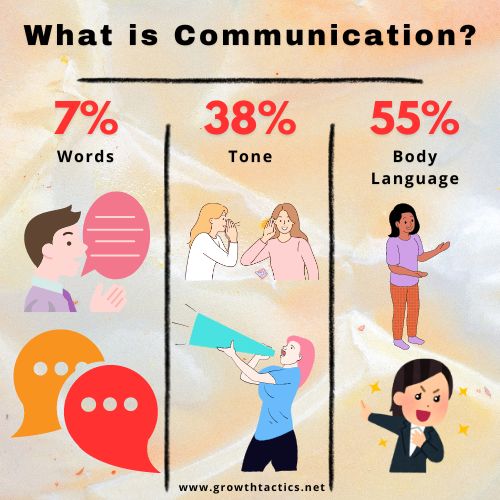Leadership communication refers to the way leaders share information, ideas, direction, and feedback with their teams and stakeholders. Effective leadership communication is essential for success in today’s fast-paced business environment. Leaders who communicate well are able to build trust, inspire action, and drive results.
According to Forbes, communication is one of the most important skills for leaders. Effective leadership communication requires certain strategies and skills – including active listening, clear messaging, choosing the right channels, and tailoring communication for the audience. Leaders must master both verbal and nonverbal communication to connect with stakeholders and have maximum impact.
In this article, we’ll cover the core strategies and skills exceptional communicators use to engage and motivate their teams. We’ll look at how leaders can build trust through transparency, encourage two-way dialogue, communicate vision, and continuously improve their communication abilities. With the right skills and commitment, leaders can transform organizational communication and performance.
Jump To Section
Build Trust and Credibility with Communication
Trust is essential between leaders and team members for organizational success. Effective leaders build trust by being open, honest, and transparent in their communication.
Leaders should make communication a priority to develop credibility. By sharing information freely, being accessible to team members, and having regular interactions, leaders demonstrate they have nothing to hide. This openness helps create mutual understanding.
When leaders communicate openly about company challenges along with successes, team members feel respected and included. Sharing business context helps teams understand the reasons behind decisions, even difficult ones. Rather than directive top-down communication, effective leaders seek input and feedback from teams. They admit when they don’t have all the answers. This humility builds trust.
Leaders build trust when team members know their thoughts and concerns will be heard. Taking time for genuine dialogue allows people to feel their voices matter. Even if leaders can’t act on all ideas, making team members feel valued strengthens bonds. Exceptional leaders go further by empowering teams to make more decisions themselves.
Trust also comes from consistency between words and actions. Leaders must walk the talk, following through on stated commitments. Reliability, integrity, and transparency in daily communication are key to credibility. By building trust, leaders inspire discretionary effort and unlock the team’s full potential.
Listen Actively and Encourage Feedback
Active listening is one of the most important communication skills for leaders. When leaders listen well, they build trust, understanding, and respect. Active listening shows team members that their thoughts, ideas, and feedback are valued.
Some benefits of active listening for leaders include:
- Building stronger relationships and credibility
- Gaining insights into team needs and concerns
- Identifying problems early before they escalate
- Improving collaboration, engagement, and productivity
Great leaders focus intently on what team members are saying without interrupting or judging. They use body language like maintaining eye contact and nodding to show interest. After someone has finished speaking, effective leaders paraphrase or ask clarifying questions to ensure the message is properly received.
Here are some tips for leaders to improve active listening skills:
- Avoid distractions and give your full attention.
- Don’t interrupt or formulate replies while the other person is speaking.
- Reflect back on what you heard and ask clarifying questions.
- Summarize the key points and ideas after the conversation.
- Pick up on nonverbal cues like facial expressions and tone.
Leaders should also encourage regular feedback from team members. An open feedback culture demonstrates that communication goes both ways. Leaders can ask for feedback directly or use anonymous surveys. It’s important to create a psychologically safe environment where people feel comfortable providing honest input without fear of consequences. Leaders should listen non-defensively to feedback and demonstrate that it’s valued by taking action based on the insights gained.
Fostering a culture of active listening and continuous feedback is essential for effective leadership communication and organizational success.
Tailor Your Message for the Audience
Effective leaders understand that different audiences require tailored communication styles and channels. What works for communicating with your team may not resonate the same way with external stakeholders or customers.
When speaking with your team, focus on connecting with them personally and appealing to their interests. Get to know your team members as individuals and tailor your language, tone, and examples to their specific needs and preferences. Casual, conversational language often works best to build rapport.
For stakeholders, use more formal, data-driven communication that focuses on business objectives, ROI, and industry trends. These audiences will respond better to clear, concise language that quickly gets to the point. Avoid using internal jargon and acronyms when speaking to external stakeholders.
When addressing customers, empathy and listening are key. Seek to understand your customers’ unique needs and perspectives. Use positive, encouraging language and be responsive to questions and concerns. Meet customers where they are by speaking to their specific pain points and desires.
The channel used to communicate should also be tailored appropriately. For quick team huddles, an informal face-to-face chat may be best. For stakeholder presentations, polished slides and handouts are preferable. For customers, channels like email newsletters or social media allow more personalization.
By taking the time to tailor messaging and channels to your audience, leaders can communicate in a more meaningful way that drives better results.

Use Clear and Consistent Communication
Effective leaders understand the importance of being clear and consistent in their communication. Ambiguous or inconsistent messaging can lead to confusion, reduced productivity, and a lack of trust.
To communicate clearly:
- Be concise. Avoid excessive wordiness. Get to the point.
- Use simple language. Avoid jargon when possible.
- Provide context. Give the background to help others understand your message.
- Be specific. Include relevant details and examples.
- Repeat key points. Emphasize important information.
- Check for understanding. Ask questions to ensure your message was received.
Leaders must also align messaging across communication channels. Having one message in an email, another in a meeting, and something different in the company newsletter breeds confusion.
Strive for consistency across all mediums, including:
- Emails
- Presentations
- Reports
- Social media
- Video messages
- Conversations
With clear, concise, and consistent communication, leaders can better convey vision, strategy, and goals to stakeholders. Misunderstandings are reduced and organizational alignment improves.
Choose the Right Medium and Channels
In today’s fast-paced business environment, leaders have many options when it comes to communication channels. Email, instant messaging, video conferencing, and even social media provide new ways to connect. However, the medium you choose impacts how your message is received.
Email is efficient for delivering information, but can lack the nuance of in-person communication. Use email for status updates, announcements, or sharing documents. But avoid lengthy discussions or sensitive topics.
Video conferencing brings you face-to-face virtually, allowing for real-time communication and reading body language. This works well for meetings, presentations, or collaborating across distances. However, technical issues can disrupt the flow.
Social media offers opportunities to connect, engage customers, and build your brand. However, the public nature requires thoughtfulness regarding company messaging. Use social channels to share insights, not confidential information.
In-person communication builds deeper connections through body language, tone, and real-time feedback. Meetings or events allow for relationship building, brainstorming, and reading the room. Yet this method requires significant time investment.
The rise of digital communication provides more ways to connect but also risks miscommunication. Leaders should match objectives to the right medium, and verify understanding. A layered approach combining digital, in-person, and print allows for effective communication.
The key is using the channels strategically to deliver the right message to the right people. Thoughtfully choose mediums aligned to your goals, audience, and message. Evaluate outcomes and improve over time for better leadership communication.
Communicate with Empathy
Effective leaders demonstrate emotional intelligence and empathy in their communication. By putting yourself in your team members’ shoes, you gain insight into their perspectives, struggles, and motivations.
Seeking to understand where others are coming from builds trust. When people feel heard and understood, they are more receptive to your message. As a leader, make a conscious effort to listen without judgment and recognize each person’s unique situation.
Leaders with empathy are attuned to the emotional undercurrents within their teams. They notice when morale is low or tensions are high. With care and compassion, empathetic leaders address difficult issues and create an environment where people feel safe to share their true feelings.
Rather than issuing directives, empathetic communicators engage in a two-way dialogue to uncover concerns. They ask thoughtful questions and listen attentively to responses. This reflective communication style helps prevent misunderstandings and conflict.
By developing your emotional intelligence as a leader, you can foster positive relationships. Your team will be more willing to communicate openly and honestly with you. They will feel valued, inspired, and invested in the organization’s success.
Encourage Two-Way Dialogue
Effective communication is not just about sending messages, but also about listening. As a leader, you need to create opportunities for honest, two-way communication within your organization.
Seeking input and feedback shows employees that their thoughts and ideas are valued. When team members feel heard, they are more engaged and motivated to contribute to organizational goals.
Two-way communication builds trust between leaders and employees. It demonstrates that you respect employees’ perspectives and are open to discussion. This helps create a culture of transparency where people feel comfortable expressing concerns or new ideas.
Some ways to encourage two-way dialogue include:
- Holding regular team meetings for open discussion of goals, issues, and ideas
- Maintaining an open-door policy so employees can approach you
- Actively soliciting feedback through surveys, conversations, or anonymous suggestion boxes
- Empowering employees to participate in decision-making processes
- Following up on conversations to show you listened and value contributions
- Addressing employee questions and concerns promptly and transparently
Two-way communication leads to better collaboration and innovation. Employees who feel heard are more engaged and perform better. Fostering open dialogue helps build a high-trust organizational culture where everyone can contribute to success.
Communicate Vision and Purpose
Effective leaders can clearly communicate the organization’s vision and purpose to the team. This gives employees a sense of meaning in their work and connects their day-to-day tasks to the company’s larger goals.
Leaders should regularly talk about the organization’s mission, values, and objectives. They need to articulate a compelling vision for the future that gets employees excited and motivated. According to Harvard Business Review, employees who find their company’s vision meaningful have engagement levels 27% higher than those who don’t.
When introducing new initiatives or changes, leaders should explain how they align with the company’s core purpose. This context helps the team understand why the change is happening and why their contributions matter. Leaders must inspire the team to work towards the shared vision while also recognizing progress along the way.
Exceptional communicators connect the team’s collaborative work to organizational success. They highlight how each person’s efforts contribute to important outcomes that advance the vision. This gives employees a sense of purpose and helps the organization achieve its strategic goals.
Invest in Improving Communication Skills
Effective leadership communication is a journey that requires continuous learning and development. Leaders must invest time and resources into improving their communication skills and strategies.
Some ways leaders can develop stronger communication are:
- Seek feedback – Ask for honest feedback from your team members and peers on how you currently communicate. What are your strengths and weaknesses? What can you improve? Be open to constructive criticism.
- Take a communication course – Invest in a formal communication or presentation skills course. There are many options for online and in-person classes to build critical skills.
- Get a leadership coach – Work one-on-one with a professional coach to practice and refine your communication abilities. They can assess your skills and provide tailored guidance.
- Assess gaps – Analyze areas where communication breakdowns frequently occur. Look for patterns where messages seem unclear or misunderstandings arise.
- Observe excellent communicators – Notice the communication strategies and styles of highly effective leaders. What makes their communication stand out? What can you emulate?
- Practice, practice, practice – Look for opportunities to practice communicating. Present at meetings, facilitate discussions, and give feedback. The more you do it, the more natural it becomes.
By continuously working on communication, leaders can become exceptional communicators. It takes commitment but is one of the most valuable investments in boosting leadership effectiveness. Strong communication skills make leading teams and organizations much easier.


